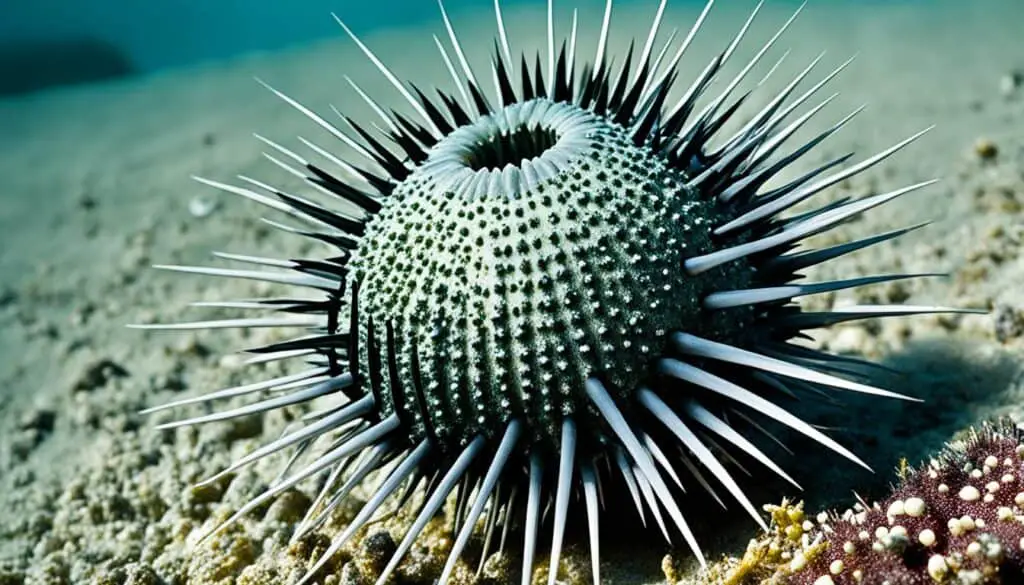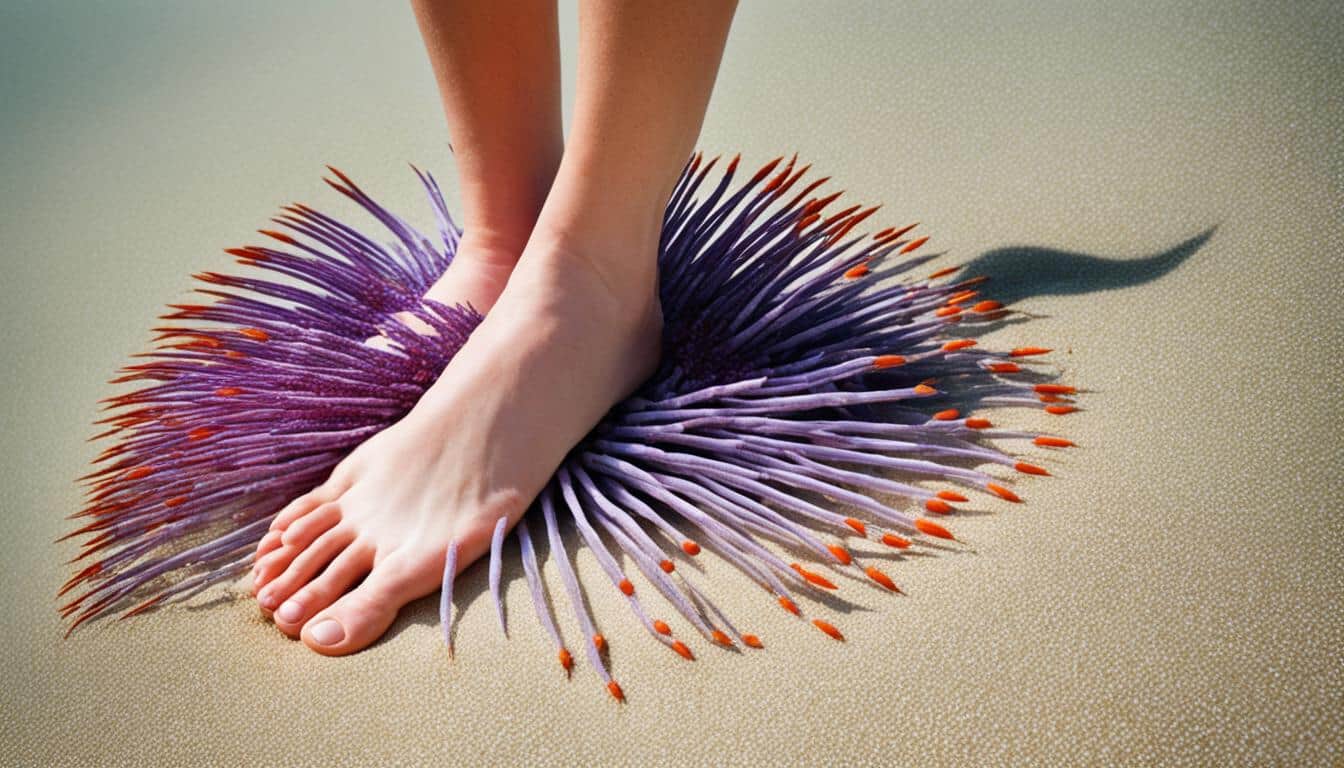Have you ever wondered if sea urchins are a threat to humans? These fascinating creatures often catch the eye of beach lovers and divers. But, handling sea urchins comes with risks. Most injuries from sea urchins happen by accident, like stepping on them in rocky areas or shallow water.
Their sharp spines and special parts called pedicellariae can sting and cause pain. It’s important to know about these dangers to enjoy the sea safely.
Introduction to Sea Urchins
Sea urchins are fascinating creatures that belong to the class Echinoidea. They come in many forms and play a big role in marine life. It’s important to know about their sea urchin classification, looks, and where they live to understand their importance in the ocean.
What Are Sea Urchins?
Sea urchins are part of the echinoderms group. They are known for their unique looks and big role in the ocean. They eat plants and are food for other sea creatures. You can find them in many colors, from black to bright pink.
Physical Characteristics of Sea Urchins
The physical characteristics of sea urchins include a tough shell and many spines for protection. These spines come in different lengths and colors, making the urchins stand out. They also have tube feet that help them move and eat.
Habitat and Distribution
Sea urchins live in many types of water all over the world. They can be found from shallow coastlines to deep sea floors. They adapt well to different ocean conditions. You can find them in warm and cold waters, showing how tough they are.
Are Sea Urchins Dangerous to Humans?
Many people enjoy activities near the coast and often meet sea urchins. These creatures don’t try to attack humans, but they can be risky. Knowing the common risks sea urchins pose is key for a safe ocean experience. This part talks about the injuries sea urchins can cause and how often they happen.
Common Risks Associated with Sea Urchins
Most sea urchin injuries happen when people step on or touch them by accident. Their sharp spines can go through the skin, causing a lot of pain. Sometimes, the spines might stay inside the wound and need a doctor to remove them. Here are some risks of meeting sea urchins:
- Spine punctures leading to local pain and swelling
- Infection from open wounds
- Difficulty walking or swimming if injuries occur on feet or legs
Statistics on Sea Urchin Injuries
Looking at sea urchin injuries statistics helps us understand how often these happen. People diving or wading are often hurt the most. Every year in the U.S., about 1,800 cases of sea urchin injuries are reported. Around 500 of these need treatment for sea urchin-related problems.
| Year | Total Aquatic Exposures | Treatments for Complications |
|---|---|---|
| 2019 | 1800 | 500 |
| 2020 | 1850 | 525 |
| 2021 | 1750 | 480 |
Understanding Sea Urchin Stings
When you touch a sea urchin, certain reactions happen. It’s good to know what happens during a sting and the symptoms that may follow. This knowledge helps you act fast and reduce any problems.
What Happens During a Sea Urchin Sting?
The sharp spines of the urchin go through the skin when you step on or touch them. Sometimes, these spines can stay in your skin, making treatment harder. Right away, you’ll feel a lot of pain and swelling where you got stung. If you don’t get help, these symptoms can get worse.
Symptoms of Sea Urchin Stings
Spotting symptoms early helps you get help quickly. Common signs of a sea urchin sting are:
- Redness at the sting site
- Swelling and tenderness
- Severe pain that spreads from the area
- Systemic reactions in bad cases, affecting your health
Knowing about sea urchin sting symptoms helps you understand how serious the injury is. It guides you on what to do next.
Toxicity of Sea Urchins
It’s important to know about the toxicity of sea urchins for safe interaction. Not all sea urchins have venom, but some can be harmful to humans. When snorkeling or diving, you might see different types, so it’s key to know which ones are toxic.
Which Species Are Toxic?
Some sea urchins are known for their venom. The flower sea urchin is a good example, with its toxic pedicellariae. Other dangerous ones include:
- Black sea urchin (Diadema spp.)
- Red sea urchin (Strongylocentrotus franciscanus)
- Pencil sea urchin (Echinothrix spp.)
Meeting these toxic sea urchins can cause a lot of pain and serious reactions. The effects depend on the species, but knowing which ones are dangerous can keep you safe.
Differences in Toxicity Among Species
Sea urchin venom varies a lot between species. For instance, the flower sea urchin has many toxins that cause a lot of pain and can lead to serious health issues like breathing problems. Other types might cause less severe reactions.
Here’s a table that shows how different toxic sea urchins affect people:
| Sea Urchin Species | Venom Potency | Symptoms |
|---|---|---|
| Flower Sea Urchin | High | Pain, paralysis, respiratory issues |
| Black Sea Urchin | Moderate | Pain, swelling |
| Pencil Sea Urchin | Low | Minor irritation, swelling |

Understanding sea urchin toxicity helps keep you safe in the water. Always be careful and know which sea urchins could be a risk. Knowing about sea urchin venom helps you have safer interactions with these interesting, yet risky, sea creatures.
How to Treat Sea Urchin Stings
Knowing how to treat sea urchin sting injuries is key to quick relief and avoiding complications. Start with immediate first aid steps. It’s important to know when to get medical help to prevent further problems.
First Aid Steps for Sea Urchin Stings
Right away, take these steps if you get a sea urchin sting:
- Put the affected area in hot water for 30 to 90 minutes. Heat can help stop the pain by neutralizing toxins.
- Use tweezers to carefully remove any visible spines. Don’t use your fingers to avoid pushing spines deeper.
- Wash the wound with soap and water to lower infection risk.
- Apply an antiseptic ointment to help it heal.
When to Seek Medical Attention
Some sea urchin stings need more than just first aid. Go to a healthcare professional if you see any of these signs:
- Severe pain that doesn’t get better.
- Swelling or redness that goes beyond the sting area.
- Signs of infection like pus or fever.
- Systemic symptoms such as trouble breathing or feeling dizzy.
Preventing Sea Urchin Injuries
When you’re in the water, taking steps to avoid sea urchin injuries is key. Always be on the lookout, especially in areas with rocks or shallow water where sea urchins live. This way, you can dodge them easily.
Wearing shoes with good grip, like water shoes or boots, helps a lot. These shoes give you stability and protect you from sea urchin stings. Also, try not to swim or walk in unclear water, especially at night. It’s harder to see and you might accidentally step on a sea urchin.
Following these tips can make your time in the water safer and more fun. Knowing how to dodge sea urchin stings keeps you safe and lets you enjoy the ocean’s wonders. Always be careful to protect yourself and respect the sea and its creatures.
FAQ
Are sea urchins dangerous to humans?
Sea urchins can be risky to humans because of their sharp spines and painful stings. They don’t usually attack, but touching them can cause injuries. This often happens when people step on them or accidentally touch them while swimming.
What are the common injuries associated with sea urchins?
The most common injuries are puncture wounds from their spines. These spines can break off and stay under the skin. Such injuries are very painful and might need medical help to remove them properly.
How many injuries are reported from sea urchin encounters?
Every year, over 1800 people in the U.S. get hurt from sea creatures, including sea urchins. About 500 of these people need treatment for sea urchin sting complications.
What symptoms should I look for after a sea urchin sting?
After a sting, you might feel intense pain, see redness, swelling, and feel sensitive at the sting spot. If the reaction is severe, you could have systemic symptoms. This means you should get help right away.
Which species of sea urchins are considered toxic?
Some sea urchins, like the flower sea urchin, have toxic parts called pedicellariae. These can cause worse reactions. So, they are more dangerous to encounter.
How does the toxicity differ among sea urchin species?
Not all sea urchins have venom. But, some have strong toxins. These can cause pain, paralysis, or breathing problems. It’s important to know which ones are toxic before you come across them.
What first aid steps should I follow if stung by a sea urchin?
For a sting, put the affected area in hot water to ease the pain. Then, carefully remove any spines that are stuck. Taking good care of the wound after is also key to avoid infection.
When is it necessary to seek medical attention after a sea urchin sting?
You should get medical help if the pain, swelling, or other symptoms don’t go away or get worse. These signs could mean a serious issue.
What precautions can I take to prevent sea urchin injuries?
To avoid getting hurt, be careful in rocky areas and wear shoes that protect your feet. Don’t swim at night. Knowing what’s around you can really help prevent accidents.







